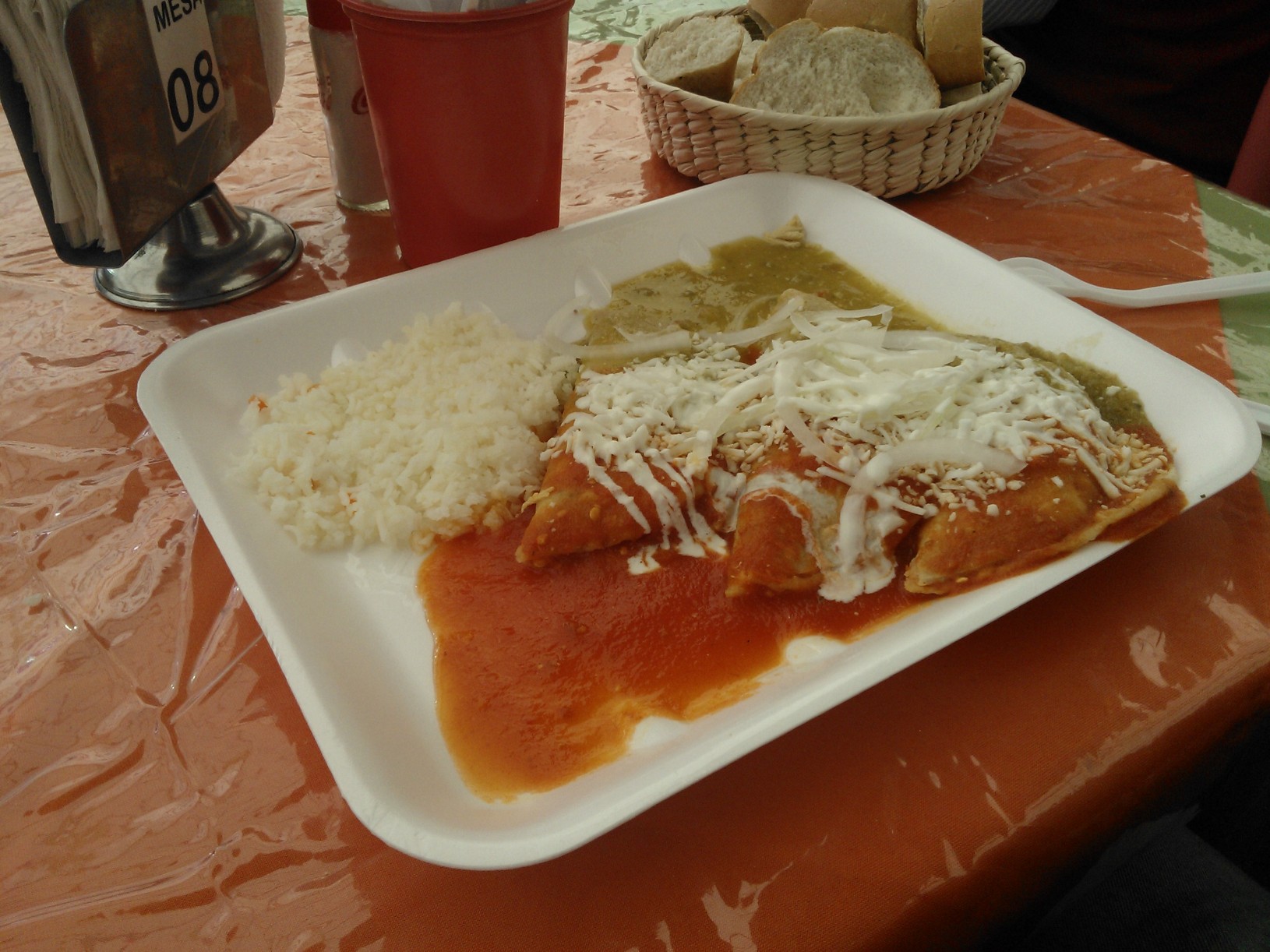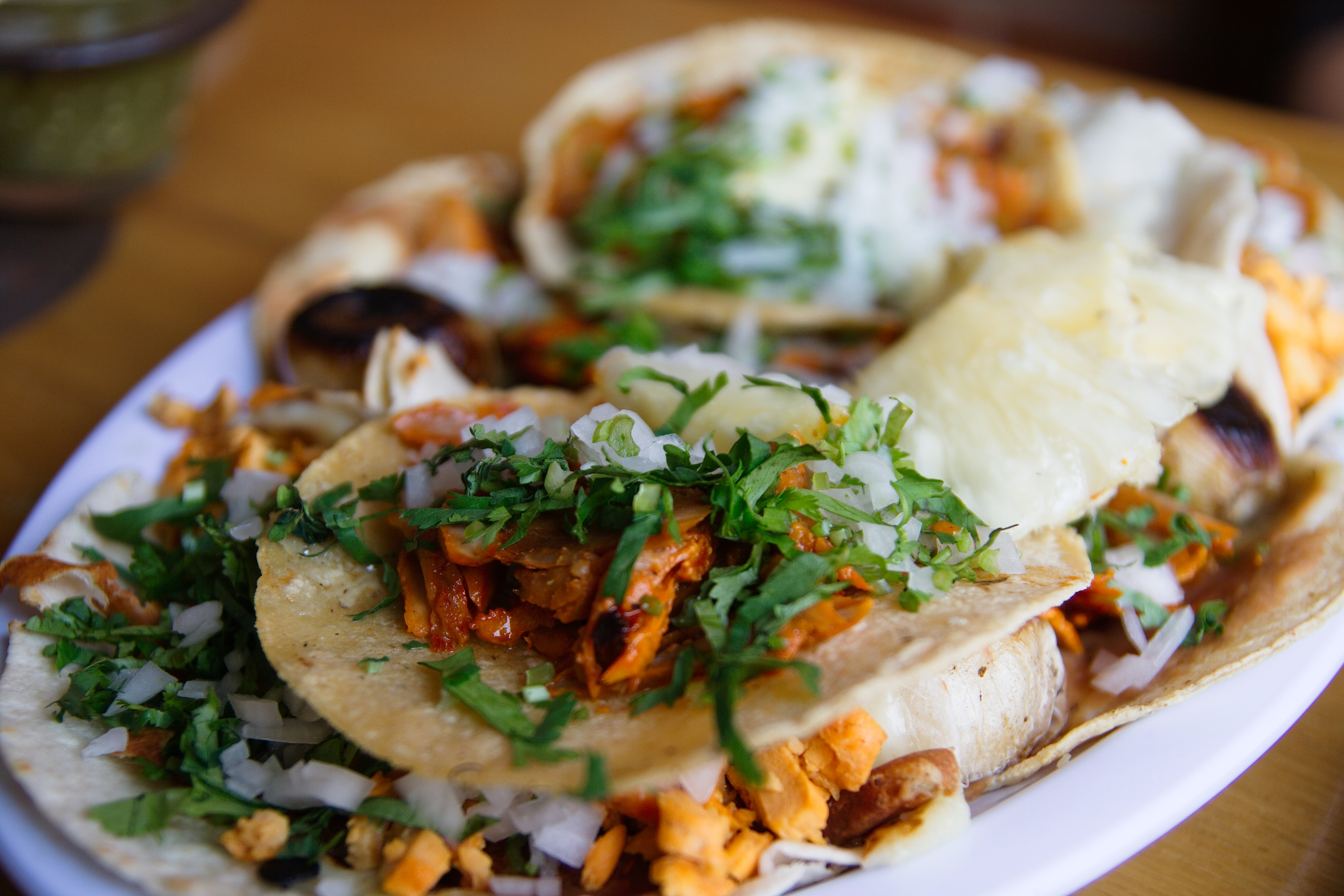|
Chile Con Queso
Chile con queso ( Spanish for "chile with cheese"), sometimes simply called queso, is an appetizer or side dish of melted cheese and chili peppers, typically served in Tex-Mex restaurants as a dip for tortilla chips. Background Chile con queso (also spelled chili con queso) is a part of Tex-Mex and Southwestern cuisine, originating in the northern Mexican state of Chihuahua as a version of Queso chihuahua and Queso flameado. Chile con queso is predominantly found on the menus of Tex-Mex restaurants in the southwest and western United States. Ingredients Chile con queso is a smooth, creamy sauce, used for dipping, that is made from a blend of melted cheeses (often Velveeta or another processed cheese, Monterey Jack or cream cheese), cream, and chili peppers. Many restaurants serve chile con queso with such added ingredients as pico de gallo, black beans, guacamole, and ground beef or pork. Serving Chile con queso is a warm dish, heated to a desired temperature. Chile c ... [...More Info...] [...Related Items...] OR: [Wikipedia] [Google] [Baidu] |
Mexico
Mexico ( Spanish: México), officially the United Mexican States, is a country in the southern portion of North America. It is bordered to the north by the United States; to the south and west by the Pacific Ocean; to the southeast by Guatemala, Belize, and the Caribbean Sea; and to the east by the Gulf of Mexico. Mexico covers ,Mexico '' The World Factbook''. . making it the world's 13th-largest country by area; with approximately 12 ... [...More Info...] [...Related Items...] OR: [Wikipedia] [Google] [Baidu] |
Tortilla Chip
A tortilla chip is a snack food made from corn tortillas, which are cut into triangles and then fried or baked (alternatively they may be discs pressed out of corn masa then fried or baked). Corn tortillas are made of nixtamalized corn, vegetable oil, salt and water. Although first mass-produced commercially in the U.S. in Los Angeles in the late 1940s, tortilla chips grew out of Mexican cuisine, where similar items were well known, such as totopos and tostadas. Though usually made of yellow corn, they can also be made of white, blue, or red corn. Tortilla chips intended to be dipped are typically only lightly salted, while others may be seasoned with a variety of flavors. History The triangle-shaped tortilla chip was popularized by Rebecca Webb Carranza in the 1940s as a way to make use of misshapen tortillas rejected from the automated tortilla manufacturing machine that she and her husband used at their Mexican delicatessen and tortilla factory in southwest Los An ... [...More Info...] [...Related Items...] OR: [Wikipedia] [Google] [Baidu] |
Enchilada
An enchilada (, ) is a Mexican dish consisting of a corn tortilla rolled around a filling and covered with a savory sauce. Enchiladas can be filled with various ingredients, including meats, cheese, beans, potatoes, vegetables, or combinations. Enchilada sauces include chili-based sauces, such as salsa roja, various moles, tomatillo-based sauces, such as salsa verde, or cheese-based sauces, such as chile con queso. Etymology The Royal Spanish Academy defines the word ''enchilada'', as used in Mexico, as a rolled maize tortilla stuffed with meat and covered with a tomato and chili sauce. ''Enchilada'' is the past participle of Spanish ''enchilar'', "to add chili pepper to"; literally, "to season (or decorate) with chili". The idiomatic American English phrase "the whole enchilada" means "the whole thing". History Enchiladas originated in Mexico, where the practice of rolling tortillas around other food dates back at least to Aztec times. The people living in the lake region ... [...More Info...] [...Related Items...] OR: [Wikipedia] [Google] [Baidu] |
Taco
A taco (, , ) is a traditional Mexican food consisting of a small hand-sized corn- or wheat-based tortilla topped with a filling. The tortilla is then folded around the filling and eaten by hand. A taco can be made with a variety of fillings, including beef, pork, chicken, seafood, beans, vegetables, and cheese, allowing for great versatility and variety. They are often garnished with various condiments, such as salsa, guacamole, or sour cream, and vegetables, such as lettuce, onion, tomatoes, and chiles. Tacos are a common form of antojitos, or Mexican street food, which have spread around the world. Tacos can be contrasted with similar foods such as burritos, which are often much larger and rolled rather than folded; taquitos, which are rolled and fried; or chalupas/ tostadas, in which the tortilla is fried before filling. Etymology The origins of the taco are not precisely known, and etymologies for the culinary usage of the word are generally theoretical. ''Taco ... [...More Info...] [...Related Items...] OR: [Wikipedia] [Google] [Baidu] |
Fajita
A fajita (; ), in Tex-Mex cuisine, is any stripped grilled meat with stripped peppers and onions usually served on a flour or corn tortilla. The term originally referred to skirt steak, the cut of beef first used in the dish. Popular alternatives to skirt steak include chicken and other cuts of beef, as well as vegetables instead of meat. In restaurants, the meat is usually cooked with onions and bell peppers. Popular condiments include shredded lettuce, sour cream, guacamole, salsa, pico de gallo, shredded cheese, refried beans, and diced tomatoes. "Arrachera", another term for skirt steak, is also applied to a northern Mexican variant of the dish. History ''Fajita'' is a Tex-Mex, Texan-Mexican American or Tejano, diminutive term for little strips of meat cut from the beef skirt, the most common cut used to make fajitas. The word ''fajita'' is not known to have appeared in print until 1971, according to the ''Oxford English Dictionary''. (The word ''faja'' is Spanish for ... [...More Info...] [...Related Items...] OR: [Wikipedia] [Google] [Baidu] |
Guacamole
Guacamole (; (informally shortened to ''guac'' in the United States since the 1980s) is an avocado-based dip, spread, or salad first developed in Mexico. In addition to its use in modern Mexican cuisine, it has become part of international cuisine as a dip, condiment and salad ingredient. Etymology and pronunciation The name comes from Classical Nahuatl , which literally translates to 'avocado sauce', from ''āhuacatl'' 'avocado' + ''mōlli'' 'sauce'. In Mexican Spanish, it is pronounced . In American English, it tends to be pronounced , and this pronunciation is also common in British English, but is more common. History Avocado seeds were first found in the Tehuacan Valley of Mexico around 9,000–10,000 years ago (7000–8000 BCE) and had been domesticated by various Mesoamerican groups by 5000 BCE. They were likely cultivated in the Supe Valley in Peru as early as 3100 BCE. In the early 1900s, avocados frequently went by the name ''alligator pear''. In the 169 ... [...More Info...] [...Related Items...] OR: [Wikipedia] [Google] [Baidu] |
Black Turtle Bean
The black turtle bean is a small, shiny variety of the common bean (''Phaseolus vulgaris'') especially popular in Latin American cuisine, though it can also be found in the Cajun and Creole cuisines of south Louisiana. Like all varieties of the common bean, it is native to the Americas, but has been introduced around the world. It is also used in Indian cuisine, Tamil cuisine, where it is known as ''karuppu kaaramani'' and in Maharashtrian cuisine, where it is known as ''Kala Ghevada''. It is widely used in Uttrakhand India also known as “Bhatt “ . It is rich source of iron and protein.The black turtle bean is often simply called the black bean (''frijoles negros'', ''zaragoza, judía negra, poroto negro, caraota negra,'' or ''habichuela negra'' in Spanish; and ''feijão preto'' in Portuguese), although this terminology can cause confusion with at least three other types of black beans. The black turtle bean is the only type of turtle bean. It is called ''turtle'' becaus ... [...More Info...] [...Related Items...] OR: [Wikipedia] [Google] [Baidu] |
Pico De Gallo
''Pico de gallo'' (, ), also called ''salsa fresca'' ('fresh sauce'), ''salsa bandera'' ('flag sauce'), and ''salsa cruda'' ('raw sauce'), is a type of salsa commonly used in Mexican cuisine. It is traditionally made from chopped tomato, onion, and serrano peppers ( jalapeños or habaneros may be used as alternatives), with salt, lime juice, and cilantro. ''Pico de gallo'' can be used in much the same way as other Mexican liquid salsas. Because it contains less liquid, it also can be used as a main ingredient in dishes such as tacos and fajitas. The tomato-based variety is widely known as ''salsa picada'' (' minced/chopped sauce'). In Mexico it is normally called ''salsa mexicana'' ('Mexican sauce'). Because the colours of the red tomato, white onion, and green chili and cilantro are reminiscent of the colours of the Mexican flag, it is also called ''salsa bandera'' ('flag sauce'). In many regions of Mexico the term ''pico de gallo'' describes any of a variety of sala ... [...More Info...] [...Related Items...] OR: [Wikipedia] [Google] [Baidu] |
Lodi News-Sentinel
The ''Lodi News-Sentinel'' is a daily newspaper based in Lodi, California, United States, and serving northern San Joaquin and southern Sacramento ) , image_map = Sacramento County California Incorporated and Unincorporated areas Sacramento Highlighted.svg , mapsize = 250x200px , map_caption = Location within Sacramento ... counties. History The ''Lodi News-Sentinel'' was founded in 1881 by Ralph Ellis, a former sheriff, farmer and flourmill operator. Ownership has changed over the years from Ralph Ellis to Samuel B. Axtell to Fordyce P. Roper and George H. Moore, to Clyde C. Church, and to Fred E. Weybret. On June 1, 2015, the paper was sold to Central Valley News-Sentinel Inc., led by veteran newspaper publisher Steven Malkowich. The new owners have newspaper assets in the United States and Canada, including several in California. The newspaper has occupied many sites, moving eight times since its ... [...More Info...] [...Related Items...] OR: [Wikipedia] [Google] [Baidu] |
Spokane Daily Chronicle
The ''Spokane Daily Chronicle'' is a daily digital newspaper in Spokane, Washington. It was founded as a weekly paper in 1881 and grew into an afternoon daily, competing with ''The Spokesman-Review'', which was formed from the merger of two competing papers. In 1897, the ''Chronicle'' was acquired by William H. Cowles and became part of the Cowles Publishing Company. Cowles already owned ''The Spokesman-Review''. Both papers operated out of the Spokesman-Review Building until 1921, but were kept independent; ''The Spokesman-Review'' had a Republican political slant, and the two papers maintained a friendly rivalry. The ''Chronicle'' moved into its own building next door in 1921. The following year the ''Chronicle'' started radio station KOE, setting up an antenna on the taller ''Review'' building. The station operated for less than a year. A ''Chronicle'' Building was first planned in 1917. The final building that remains standing today was designed by G.A. Pehrson in downtow ... [...More Info...] [...Related Items...] OR: [Wikipedia] [Google] [Baidu] |
Oxnard Press-Courier
''The Oxnard Press-Courier'' was a newspaper located in Oxnard, California, United States. It ceased publication in June 1994 after 95 years.Oxnard Paper to Call It Quits Thursday '''', June 14, 1994 ("The 95-year-old ''Oxnard Press-Courier'' will publish its last edition Thursday, making it the third newspaper to cease publication in in the past 1 years. Citing the state's troubled economy and the county's competitive newspaper market, newspaper officials announced Monday ... [...More Info...] [...Related Items...] OR: [Wikipedia] [Google] [Baidu] |
Houston Chronicle
The ''Houston Chronicle'' is the largest daily newspaper in Houston, Texas, United States. , it is the third-largest newspaper by Sunday circulation in the United States, behind only ''The New York Times'' and the ''Los Angeles Times''. With its 1995 buy-out of long-time rival the '' Houston Post'', the ''Chronicle'' became Houston's newspaper of record. The ''Houston Chronicle'' is the largest daily paper owned and operated by the Hearst Corporation, a privately held multinational corporate media conglomerate with $10 billion in revenues. The paper employs nearly 2,000 people, including approximately 300 journalists, editors, and photographers. The ''Chronicle'' has bureaus in Washington, D.C. and Austin. It reports that its web site averages 125 million page views per month. The publication serves as the " newspaper of record" of the Houston area. Previously headquartered in the Houston Chronicle Building at 801 Texas Avenue, Downtown Houston, the ''Houston Chroni ... [...More Info...] [...Related Items...] OR: [Wikipedia] [Google] [Baidu] |





.jpg)
.jpg)
